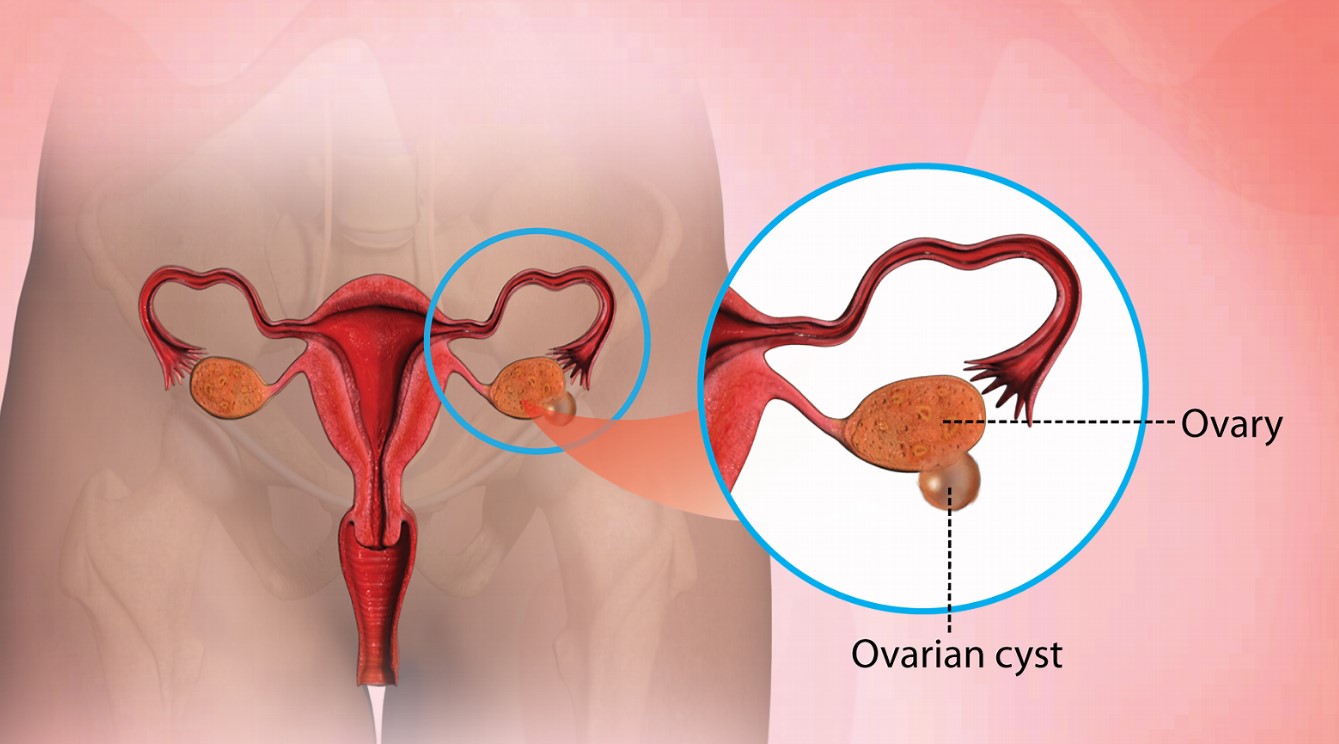
26 Aug What is Ovarian Cyst: Symptoms, Causes, and Treatment
Ovarian cysts can be likened to pimples in the female reproductive system. While they are primarily benign, they can be bothersome and, in some cases, painful. This article delves into the various aspects of ovarian cysts, including their symptoms, causes, types, diagnosis, and treatment options.
Recognizing the Symptoms of an Ovarian Cyst
Ovarian cysts may not present noticeable symptoms unless they rupture, become large, or twist, compromising the blood supply to the ovaries. In such scenarios, women might experience the following:
- Pain during intercourse
- Frequent urination
- Pelvic pain
- A sensation of fullness after eating only a small amount
- Abdominal bloating and swelling
- Difficulty with bowel movements
- Irregular menstrual cycles
- Challenges with conception
Deciphering the Causes of Ovarian Cysts
Several factors can lead to the development of ovarian cysts, including:
- Hormonal Issues: Functional cysts often resolve without treatment and are typically linked to hormonal imbalances or medications that stimulate ovulation.
- Endometriosis: Women with endometriosis may develop endometriomas—cysts formed from tissue that attaches to the ovaries, potentially causing pain during menstruation or intercourse.
- Pregnancy: A cyst may form in early pregnancy to support the pregnancy until the placenta develops, but it can sometimes persist and require surgical removal.
- Pelvic Infections: Severe infections can spread to the ovaries and fallopian tubes, leading to the formation of cysts.
Diagnosis of Ovarian Cysts
When symptoms suggest the presence of an ovarian cyst, a healthcare professional will likely perform a physical examination and may conduct an internal (vaginal) examination to detect any unusual masses. Additional diagnostic methods include:
- Ultrasound Scan: A non-invasive test that uses sound waves to create images of the internal structures. The technician will apply a probe on the abdomen and may also use a smaller probe vaginally to obtain clearer images of the ovaries.
- Blood Test: Typically performed alongside an ultrasound, a normal CA-125 result can lower the suspicion of cancer. A combination of reassuring ultrasound results and normal blood tests can further eliminate cancer as a concern.
- MRI or CT Scan: These may be recommended if the ultrasound findings are inconclusive or if CA-125 levels are elevated, although they are usually unnecessary for most benign cysts.
Types of Ovarian Cysts
Ovarian cysts vary in type, each with distinct characteristics. Most cysts are functional and arise due to hormonal fluctuations during the menstrual cycle.
- Functional Cysts: Not associated with any disease, these develop during ovulation and often resolve without treatment.
- Corpus Luteum Cysts: Formed from the corpus luteum, which develops after the ovary releases an egg, these cysts occur when the corpus luteum fills with fluid.
- Follicular Cysts: These arise when a follicle fails to release an egg during ovulation and instead fills with fluid.
- Endometriomas: Formed from endometrial tissue, these cysts are common in women with endometriosis.
- Dermoid Cysts: Also known as teratomas, these contain various tissue types, such as hair, teeth, and skin, and develop from reproductive cells in the ovary.
Treatment of Ovarian Cysts
Most ovarian cysts do not require treatment and often resolve within a few months. The need for treatment depends on factors such as the cyst’s size, appearance, the presence of symptoms, and whether the woman has gone through menopause. Treatment options include:
- Watchful Waiting: Monitoring small, asymptomatic cysts with regular ultrasound scans allows healthcare providers to track changes. For postmenopausal women, more frequent monitoring may be necessary due to the slightly increased risk of ovarian cancer. If a cyst persists or enlarges, surgery may be indicated.
- Surgery: Larger or symptomatic cysts, or those raising concerns about cancer, typically require surgical removal. The two main surgical options are:
- Laparoscopy: A minimally invasive procedure to remove the cyst.
- Laparotomy: A more invasive surgery for larger or more complex cysts.
Natural Tips to Shrink Ovarian Cysts
In addition to medical treatments, certain natural remedies may help manage symptoms and potentially reduce cyst size:
- Hot Compress: Applying heat can promote fluid drainage from cysts. This method is especially effective for liquid-filled epidermoid cysts and may help maintain fluid balance in the body.
- Massage: Pain from an ovarian cyst can cause muscle tension. Massaging the lower abdomen, thighs, and back may help alleviate discomfort.
- Relaxation Techniques: Stress can exacerbate pain. Practices such as yoga, meditation, and deep breathing exercises can help reduce anxiety and improve overall well-being.
Seeking Medical Attention
If symptoms such as irregular menstruation or bloating persist, it’s essential to consult a healthcare professional to prevent complications. For expert care and guidance regarding ovarian cysts, consult Dr. Usha M. Kumar, a renowned gynecologist in Delhi.




Sorry, the comment form is closed at this time.